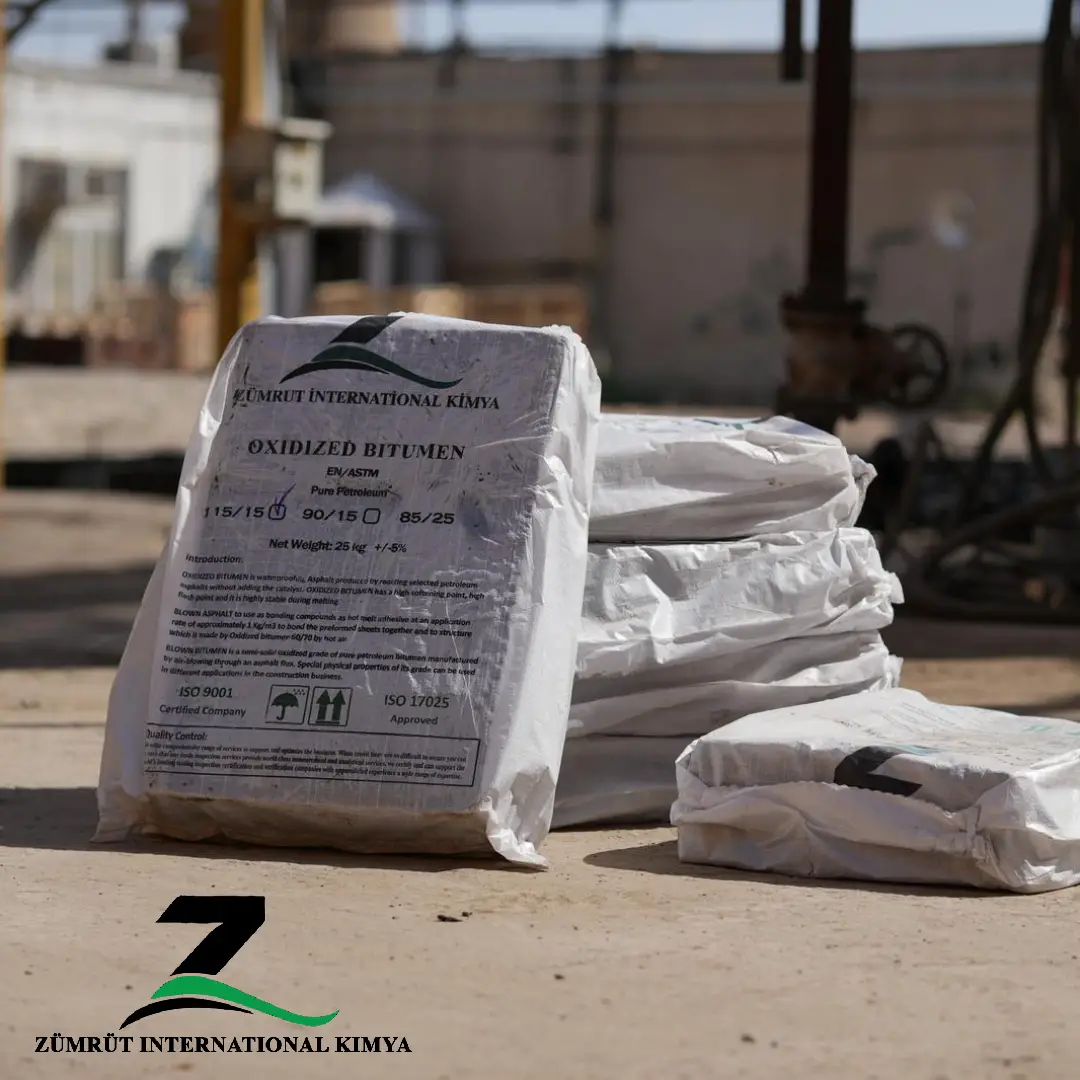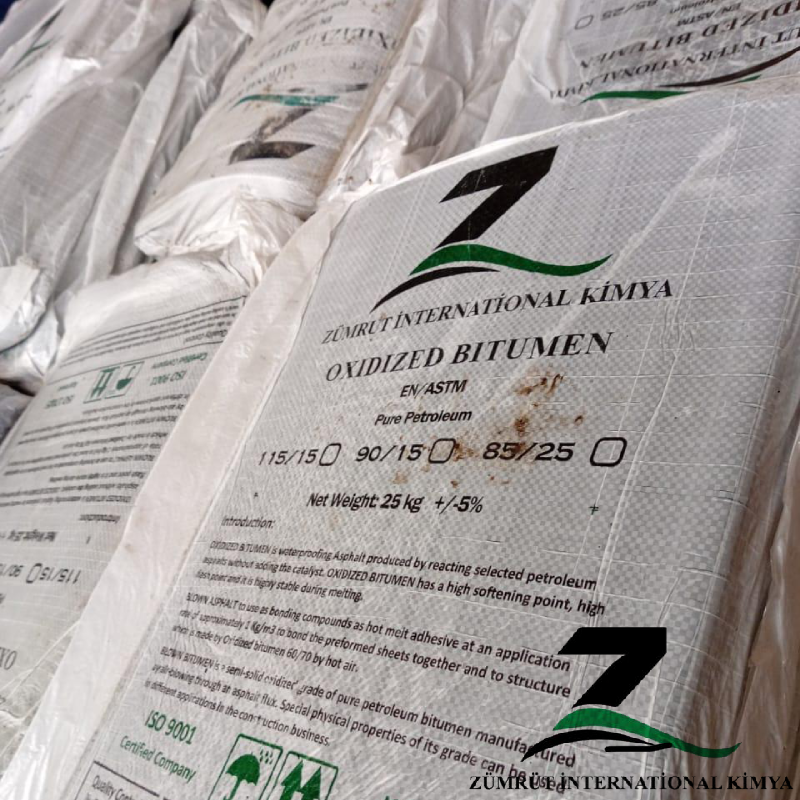
Oxidized Bitumen 90/10 Definition
Oxidized Bitumen 90/10 refers to a specific grade of bitumen that has undergone a controlled oxidation process. The numbers “90/10” typically indicate the penetration and softening point properties of the bitumen.
In this case:
– “90” represents the penetration value, which indicates the hardness or consistency of the bitumen. A lower penetration value indicates a harder bitumen.
– “10” represents the softening point, which is the temperature at which the bitumen softens under specific conditions. A higher softening point indicates a bitumen with greater temperature resistance.
Oxidized Bitumen 90/10 is commonly used in various applications such as road construction, waterproofing, and roofing, where durability and temperature resistance are important factors. The controlled oxidation process alters the properties of bitumen to enhance its characteristics for specific applications.
- Chemical Properties
Carbon Content: ~87%
Hydrogen Content: ~10%
Oxygen Content: ~3%
Sulfur Content: ~0.5–2.0% - Physical Properties
Appearance: Black, solid material at room temperature.
Melting Point: Typically around 85–90°C.
Thermal Stability: Excellent thermal resistance, suitable for applications requiring stability in high temperatures.
Blown Asphalt 90/10 Applications
Blown Asphalt 90/10 finds applications in various industries due to its unique properties. Some common applications include:
- Road Construction: It is used as a binder in asphalt mixtures for road paving, providing enhanced durability and resistance to deformation under heavy traffic loads and varying weather conditions.
- Roofing: Oxidized Bitumen 90/10 is utilized in roofing membranes and waterproofing systems to create a protective barrier against water infiltration and weathering, extending the lifespan of buildings and structures.
- Waterproofing: It is employed in the construction of bridges, tunnels, basements, and other infrastructure projects to provide waterproofing and protection against moisture ingress, corrosion, and deterioration.
- Pavement Preservation: Oxidized Bitumen 90/10 is used in pavement preservation treatments such as chip seals and slurry seals to rejuvenate and extend the service life of existing asphalt surfaces.
- Expansion Joints: It is utilized as a joint filler and sealant in concrete pavement expansion joints to accommodate thermal expansion and contraction while preventing water penetration and pavement deterioration.
- Industrial Applications: Blown Asphalt 90/10 finds use in various industrial applications such as pipe coating, manufacturing of adhesives and sealants, and as a raw material for the production of bituminous paints and coatings.
Packing of Blown Bitumen 90/10
ZUMRUT Co is the manufacturer of Blown Bitumen 90/10 in various packing, including bitumen 90/10 is available in 20 & 50 kg Kraft Paper Bags / Poly Amide Bags, 25 kg Carton box and 150, 180, 200kg Steel Drums. In addition, oxidized bitumen packing also palletize, 40 bags can stack on the pallet. 20 pallet can load to the 20ft container.

Recommendations for Handling / Storage Blown Asphalt 90/10
Handling and storing Oxidized Bitumen 90/10 requires careful attention to ensure its quality and usability. Here are some recommendations:
- Storage Temperature: Store Blown Asphalt 90/10 in a covered area away from direct sunlight and heat sources to prevent overheating and degradation. The recommended storage temperature is typically between 15°C to 25°C (59°F to 77°F).
- Avoid Contamination: Prevent contamination by storing Oxidized Bitumen 90/10 away from substances such as solvents, fuels, and acids. Ensure the storage area is clean and free from debris.
- Ventilation: Ensure adequate ventilation in the storage area to prevent the accumulation of fumes and maintain a safe working environment.
- Protection from Moisture: Protect the material from moisture by storing it in sealed containers or tanks. Moisture can degrade the quality of Oxidized Bitumen 90/10 and affect its performance in asphalt mixtures.
- Handling Precautions: When handling Oxidized Bitumen 90/10, use appropriate personal protective equipment, including gloves, safety glasses, and protective clothing, to prevent skin contact and inhalation of fumes.
- Avoid Overheating: Do not expose Oxidized Bitumen 90/10 to temperatures above its softening point during storage or handling to prevent premature aging and degradation.
- Segregation Prevention: Avoid segregation during transportation and handling by using proper equipment and procedures to maintain uniformity and consistency of the material.
Technical Advantages of Blown Bitumen 90/10
Blown Bitumen 90/10 offers several technical advantages:
- High Softening Point: Blown bitumen has a higher softening point compared to regular bitumen, making it suitable for applications requiring greater resistance to temperature fluctuations and deformation.
- Improved Durability: Its enhanced properties contribute to improved durability, making it ideal for heavy traffic areas and extreme weather conditions.
- Enhanced Cohesion and Adhesion: Blown bitumen exhibits improved cohesion and adhesion properties, resulting in better bonding with aggregates and surfaces, leading to longer-lasting pavements.
- Resistance to Aging and Oxidation: Blown bitumen tends to resist aging and oxidation better than conventional bitumen, prolonging the life of pavement surfaces.
- Flexibility and Versatility: It offers flexibility in formulation and application, allowing for customized blends tailored to specific project requirements.
- Reduced Rutting and Rutting Resistance: Blown bitumen’s higher viscosity and stiffness help reduce rutting, enhancing the overall performance of asphalt pavements.
Technical Data Sheet of Blown Bitumen 90/10
| Bitumen 90/10 | Test method | Unit | Specification |
| Specific gravity @25/25 C | ASTM D70 | (Kg/m3) | 1.05 approx. |
| Penetration @ 25°c | ASTM D5 | mm/10 | 15-May |
| Softening point °c | ASTM D36 | °C | 85/95 |
| Ductility @25 °c | ASTM D113 | Cm | 1.5min |
| Loss on heating(wt) % | ASTM D6 | Wt. % | 0.2 max |
| Flashpoint c | ASTM D92 | °C | 250 min |
| Solubility is CS2(wt) % | ASTM D4 | Wt. % | 99.5 max |
| Spot test | A.A.S.H.O.T102 | — | Negative |



